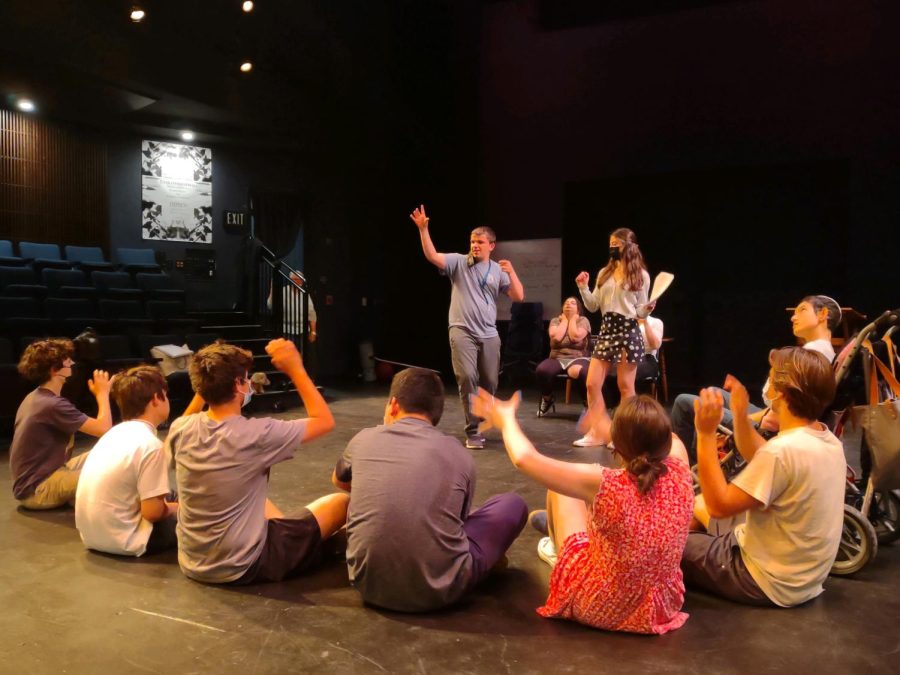The Lovejoy Project
Mar 23, 2023
“Communication isn’t just about learning how to pronounce words. It’s having the desire to share ideas. And art does just that. It shares ideas, it shares our feelings,” Michael Lovejoy, Tamalpais High School’s special education teacher, said in regards to the upcoming, annual collaboration between his students and the Conservatory Theatre Ensemble (CTE).
This spring will mark the 12th year that Lovejoy’s class has participated in CTE’s Spring One Act Festival. The Lovejoy Project sees a dozen sophomores in CTE join the Lovejoy class in creating an original one-act play. Both the Lovejoy and CTE students write, act, and help design the production. The play is also directed by Tam seniors, Gigi Shulman and Emma Korolev, who are a part of CTE’s advanced drama and directing programs.
The Lovejoy Project started 12 years ago, when the idea was proposed to Lovejoy by the class’s speech therapist at the time, Sophie Miles, as well as CTE’s Co-Program Directors, Ben Cleaveland and Julianna Rees. The goal of the project was to create a new way for the Lovejoy students to express themselves.
When speaking of the creation of the project, Lovejoy said they asked themselves, “How can we give students who sometimes have no voice, or very little voice, a voice to express themselves?”
The project also aimed to help CTE students step outside of their comfort zone, or norm, and work with people who had different abilities than them.
“I think we think of stepping outside of our comfort zone a lot in theater as just making big choices on stage, but it’s also being able to interact with people who are different from you,” Korolev said. When speaking about the process, Korolev continued to say, “It’s a big, fun party of just being able to come together and celebrate our love for theater.”
Korolev has been participating in this project since her sophomore year. Originally she was a CTE sophomore who acted in the production and assisted with the writing. After co-directing the project last year, she has returned to direct it for a second time.
“It’s my favorite thing to do, it’s so fun and I’m so thankful that Julianna [Rees] has let me do it for so many years,” Korolev said. “It’s been so magical to go from acting in it to directing it, and being behind the scenes and figuring out how to make it all work.”
In contrast to Korolev, this year is Shulman’s first time working with Lovejoy’s class and on this project. Shulman was originally not a part of this year’s production, but after meeting the Lovejoy class, she was immediately welcomed into the community and the project.
“I met Mr. Lovejoy a few weeks back when I was in the Student Center. We got to talking about him and his class and he introduced me to some of the students,” Shulman said. “I really just became enthralled with their work ethic and kindness and the amazing aids in the class. I really just wanted to keep coming back and hanging out with them.”
Shulman continued to explain her integration into her directing role in the project, “I asked one day if I could join them in rehearsal and I just never stopped going.”
The project was originally intended to be performed once, but it was so successful that it has now transformed into an annual event in the Tam community over the past decade. When speaking of this, Lovejoy explained how the show was not only successful in terms of the audience enjoying it, but also because the Lovejoy students experienced “the human benefit of being a team, of being loved, of being seen, and of being heard.”
When speaking about the writing process of the project, Lovejoy explained how, with the guidance of Rees, they touched on three main questions: What makes you feel happy? What makes you feel safe? What makes you feel afraid? After exploring these ideas, the class then focuses on how to translate these feelings to the audience.
“How do we share those emotions to a public, so the public can hear what we’re saying with their eyes and ears and hearts? How do we share that and connect those feelings and the essence of being a human being?” Lovejoy questioned.
Not only does The Lovejoy Project provide an opportunity for growth and exploration for both the Lovejoy students and CTE students, but it also helps strengthen the relationship between the Lovejoy class and the greater student body. Since the Lovejoy students take a separate set of classes, and spend a majority of their time in the student center, most Tam students don’t get the chance to meet or interact with them. Shulman believes that The Lovejoy Project helps deconstruct that divide between students and helps integrate the Lovejoy class into the student body and Tam community.
When speaking on that aspect of the project, Shulman said, “It breaks down stereotypes and biases about the Lovejoy class and about their skills and what they are capable of doing, because they are capable of doing so much more than I think a lot of people give them credit for.”
Shulman continued, “Yes, it’s us making a play, but it’s also so much more than that. It’s building a community, it’s learning skills that you can’t learn anywhere else, and just creating a bond together. I’m really excited for [the production] and for people to see it and for people to appreciate it.”
The Lovejoy Project will be performed two times during CTE’s Spring One Act Festival. Exact dates will be announced at a later time on CTE’s website.




